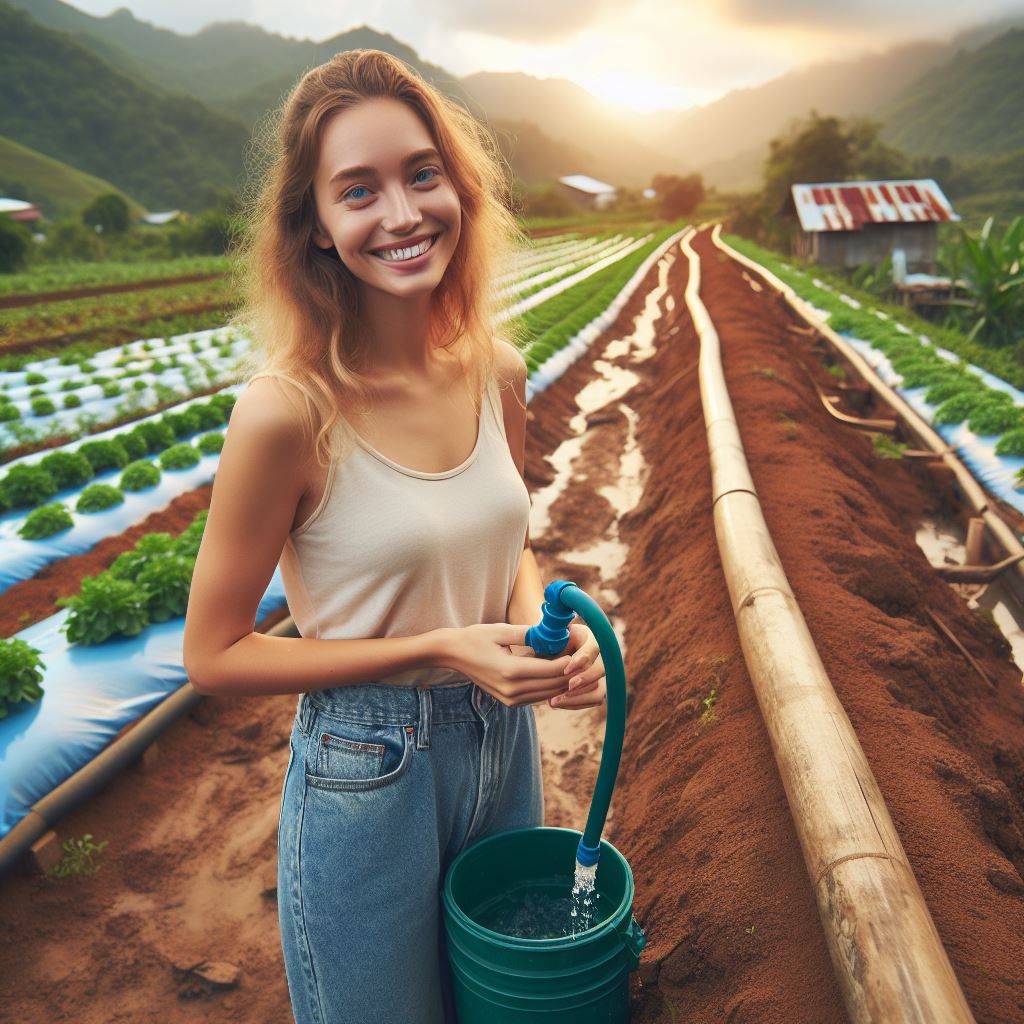Introduction
Flood barriers in modern farming are physical structures built to prevent floodwater from damaging farmland.
Brief explanation of flood barriers in modern farming
Flood barriers play a crucial role in safeguarding farmlands from the destructive impact of floods.
Importance of flood barriers in protecting farmlands
Flood barriers safeguard farmlands from devastating inundations, preserving vital agricultural resources.
By mitigating water overflow, they shield crops, livestock, and infrastructure, ensuring food security and economic stability.
Their resilience bolsters communities against climate-induced disasters, fostering sustainable farming practices and safeguarding livelihoods against the ravages of floods.
Overview of the blog post structure
In this blog post, we will explore the importance of flood barriers in modern farming and discuss their various types and benefits
Different types of flood barriers, such as levees, flood walls, and floodgates, serve as protection mechanisms.
Levees are earthen embankments constructed along rivers to contain floodwaters and prevent overflow.
Flood walls are solid barriers made of concrete or steel that shield farmlands from rising water levels.
Floodgates are movable structures that control the flow of water and prevent inundation in designated areas.
The significance of flood barriers lies in their ability to safeguard crops, livestock, and infrastructure.
They help farmers avoid substantial financial losses by protecting their investments in agriculture.
Flood barriers also have environmental advantages, as they prevent soil erosion and water pollution during flooding.
Flood barriers should be carefully designed and regularly maintained to ensure their effectiveness.
The construction of flood barriers requires engineering expertise and a comprehensive understanding of local flood patterns.
Ongoing monitoring and maintenance are necessary to address issues like erosion or structural damage.
In essence, flood barriers are indispensable in modern farming as they shield farmlands from the devastating impacts of floods.
Transform Your Agribusiness
Unlock your farm's potential with expert advice tailored to your needs. Get actionable steps that drive real results.
Get StartedTheir significance goes beyond protecting valuable agricultural assets, extending to environmental and economic benefits.
By utilizing well-designed flood barriers, farmers can mitigate the risks associated with flooding and secure their livelihoods.
Read: Agroforestry: Combining Trees and Crops
Types of Flood Barriers Used in Modern Farming
Flood barriers play a crucial role in modern farming by protecting agricultural land from the devastating effects of flooding.
They act as protective structures that prevent floodwaters from inundating valuable crops, farm buildings, and infrastructure.
Depending on the specific requirements and location, different types of flood barriers are employed to safeguard farmland against flood-related risks.
Earthen Barriers
Earthen barriers are constructed using soil or clay, making them a natural and cost-effective option.
These barriers are characterized by their ability to blend seamlessly with the environment, minimizing the visual impact.
The construction process involves compacting layers of soil and shaping them into walls, ensuring their stability.
However, earthen barriers are susceptible to erosion and require regular maintenance to retain their effectiveness.
Additionally, certain locations may not be suitable for these barriers due to soil composition or water table levels.
- Earthen barriers are structures made of soil or clay with specific characteristics.
- The construction process involves compacting layers of soil and shaping them into walls.
- Earthen barriers are cost-effective, environmentally friendly, and blend well with the surroundings.
- However, they can be vulnerable to erosion, require regular maintenance, and may not be suitable for all locations.
Temporary Barriers
Temporary barriers are designed to provide short-term flood protection during imminent flooding events.
They can be quickly deployed and offer flexibility in terms of positioning and removal.
Flood bags, sandbags, and inflatable barriers are commonly used types of temporary barriers.
In general, These barriers are placed strategically to redirect or contain floodwaters.
While they are effective in preventing flooding, temporary barriers have limitations.
They have a limited lifespan and may not be reusable, requiring replacement after each use.
- Temporary barriers are designed to be deployed quickly before an impending flood event.
- They can come in various forms, such as flood bags, sandbags, or inflatable barriers.
- Installing temporary barriers involves placing the barriers in strategic locations to redirect or contain the floodwater.
- Despite their effectiveness, temporary barriers have limitations in terms of lifespan and reusability.
Permanent Barriers
Permanent barriers are designed to withstand floods over an extended period, offering long-term protection.
They are constructed using materials such as concrete, steel, or a combination of both.
Permanent barriers provide durability, stability, and reliable flood protection.
Due to their robust construction, these barriers require regular maintenance to ensure their efficiency and longevity.
Periodic inspections and repairs are necessary to address any damage or degradation over time.
- Permanent barriers are built to withstand floods for an extended period, providing long-term protection.
- Construction materials for permanent barriers often include concrete, steel, or a combination of both.
- These barriers offer durability, stability, and a higher level of flood protection.
- Regular maintenance is required to ensure their effectiveness and functionality.
All in all, the implementation of flood barriers in modern farming is vital to mitigate the potential damage caused by flooding.
Earthen barriers, despite their vulnerability to erosion, offer cost-effective protection.
Showcase Your Farming Business
Publish your professional farming services profile on our blog for a one-time fee of $200 and reach a dedicated audience of farmers and agribusiness owners.
Publish Your ProfileFurthermore, Temporary barriers provide quick and flexible solutions, while permanent barriers offer durable and long-term flood protection.
Each type of barrier has its advantages and limitations, and the choice depends on the specific requirements, location, and budget of the farming operation.
Effective flood barrier systems can safeguard agricultural land, ensuring the continuity and productivity of modern farming practices.
Read: Urban Farming: A Climate Resilient Shift
Factors to Consider in Choosing Flood Barriers
When it comes to modern farming, flood barriers play a crucial role in ensuring the safety and productivity of agricultural lands.
With climate change causing an increase in extreme weather events, such as heavy rainfall and flooding, farmers need to carefully consider their options when choosing flood barriers.
Several factors contribute to making an informed decision.
Farm Location and Environment
- Proximity to water bodies and flood-prone areas: must assess the farm’s proximity to rivers, lakes, or other water bodies that may overflow during heavy rainfall. Understanding the potential for flood risk is vital for selecting the appropriate barrier.
- Climate conditions and typical flood severity: Different regions experience varying levels of rainfall and flood severities. Familiarizing oneself with the local climate patterns helps determine the intensity and frequency of floods, allowing farmers to choose a flood barrier that can withstand those conditions.
- Soil type and potential water saturation: The type of soil on the farm affects its ability to absorb water. Farmers should consider the soil’s drainage capacity and the risk of water saturation when selecting suitable flood barriers.
Farm Size and Layout
- Size of protected area: The size of the farm and the area to be protected from floods play a vital role in barrier selection. Smaller farms may require less extensive flood protection measures compared to larger agricultural properties.
- Landscape features affecting water flow and accumulation: The natural landscape features, such as slopes and depressions, influence water flow and accumulation during floods. Farmers need to assess these factors to choose barriers that redirect or contain floodwater effectively.
- Accessibility for barrier installation and maintenance: The ease of barrier installation and ongoing maintenance is crucial. Farmers should consider the accessibility of their land, ensuring that barriers can be easily installed, inspected, and repaired when necessary.
Cost Considerations
- Initial investment: The cost of purchasing and installing flood barriers can vary significantly. Farmers must evaluate their budget and choose barriers that offer an optimal balance between cost and effectiveness.
- Long-term maintenance expenses: Some flood barriers may require regular maintenance to ensure their functionality over time. Farmers need to consider the additional costs associated with maintenance and factor them into their decision-making process.
- Comparison of cost-effectiveness for different barrier types: There are various types of flood barriers available, each with its advantages and disadvantages. Farmers should compare the overall cost-effectiveness of different options and choose the one that best suits their specific needs and budget.
In summary, when selecting flood barriers for modern farming, farmers must consider several key factors.
The farm’s location and environment, including proximity to water bodies, climate conditions, and soil type, play a significant role.
The size and layout of the farm, along with accessibility for installation and maintenance, are also crucial considerations.
Lastly, cost considerations, including the initial investment, long-term maintenance expenses, and cost-effectiveness of different barrier types, are essential for making an informed decision.
By carefully evaluating these factors, farmers can choose flood barriers that provide effective protection for their agricultural lands.
Read: Hydroponics: Farming’s Future in Water Crisis

Benefits of Flood Barriers in Modern Farming
Protection of Crops and Livestock
Flood barriers play a crucial role in modern farming by providing numerous benefits to farmers and their agricultural practices.
One of the key advantages is the protection they offer to crops and livestock.
- Prevention of crop damage and yield loss: Flood barriers act as a shield against excess water, preventing crops from being submerged and damaged. By controlling water levels, farmers can save their harvest and avoid significant yield losses.
- Reducing health risks to livestock: Floods can pose serious health hazards to livestock, exposing them to diseases and infections. Flood barriers actively create a protective shield, reducing the chance of animals being exposed to contaminated water, thus actively promoting livestock welfare.
- Safeguarding valuable farming assets: Farming assets, such as machinery, equipment, and infrastructure, are crucial for proper farm functioning. Flood barriers help protect these assets from water damage, ensuring their longevity and saving farmers from expensive replacements or repairs.
Maintenance of Soil Quality
Flood barriers also contribute to maintaining soil quality, which is essential for sustainable farming practices.
- Avoiding erosion and soil degradation: Excessive water caused by floods can lead to soil erosion and degradation. Flood barriers prevent water from eroding fertile topsoil, preserving its structure and composition. This, in turn, helps to maintain the productivity of the land.
- Minimizing nutrient and sediment loss: Floodwaters carry away essential nutrients and sediments from the soil. Flood barriers act as a filter, capturing and retaining these elements, ensuring they remain available for plant uptake. By minimizing nutrient loss, farmers can optimize crop growth and yield.
Economic and Environmental Impact
Flood barriers have a significant impact on both the economic and environmental aspects of modern farming.
- Importance of sustainable farming practices: Integrating flood barriers as part of modern farming practices promotes sustainability. By safeguarding crops, livestock, and soil, farmers can continue to meet the needs of the present without compromising the ability of future generations to meet their own needs.
- Mitigating financial losses due to floods: Flooding can lead to substantial financial losses for farmers, including damage to crops, livestock, and infrastructure. Flood barriers act as financial safeguards, reducing the economic impact of floods by minimizing losses and preserving farm profits.
- Preserving ecological balance in farming regions: Flood barriers help maintain the ecological balance of farming regions by preventing contamination of water bodies. By keeping excess water contained within designated areas, farmers can prevent pollutants and harmful substances from entering nearby ecosystems, preserving the overall environmental health of the region.
In essence, flood barriers offer significant benefits in modern farming practices.
They protect crops and livestock, maintain soil quality, and have positive economic and environmental impacts.
By incorporating flood barriers into agricultural systems, farmers can ensure the sustainability and success of their operations.
Read: Biochar Usage: Farmers’ Weapon Against CO2
Conclusion
Recap of flood barrier types and considerations
Throughout this blog post, we’ve examined various flood barriers commonly utilized in modern farming.
From raised beds and terraces to levees and flood walls, farmers have numerous options to protect their crops from flooding.
It is essential for farmers to consider factors such as soil type, water flow, and budget when selecting the most suitable flood barrier for their farms.
Significance of flood barriers in modern farming
Flood barriers play a vital role in ensuring the success and sustainability of modern farming practices.
With extreme weather events becoming more frequent, farmers need reliable protection against floodwaters that can devastate their crops and livelihoods.
Implementing effective flood barriers not only safeguards agricultural productivity but also mitigates soil erosion and water contamination, preserving the long-term health of the farm.
Encouragement for farmers to invest in flood protection measures for long-term success and sustainability:
Investing in flood protection measures is crucial for the long-term success of farmers.
While it may require initial expenses, the benefits of flood barriers far outweigh the costs.
With flood barriers in place, farmers can minimize crop loss, increase yield, and maintain farm profitability.
Additionally, adopting these measures demonstrates resilience and sustainability in farming practices, enhancing the reputation and marketability of their produce.
In closing, flood barriers are indispensable tools for farmers in mitigating the risks and effects of flooding.
By choosing the appropriate flood protection measures and investing in their implementation, farmers can secure their farms’ future and contribute to a resilient and sustainable agricultural sector.




